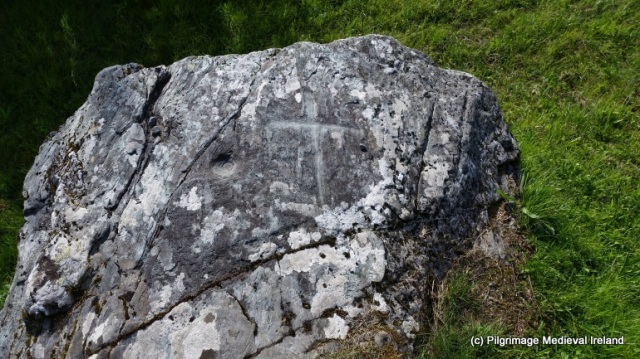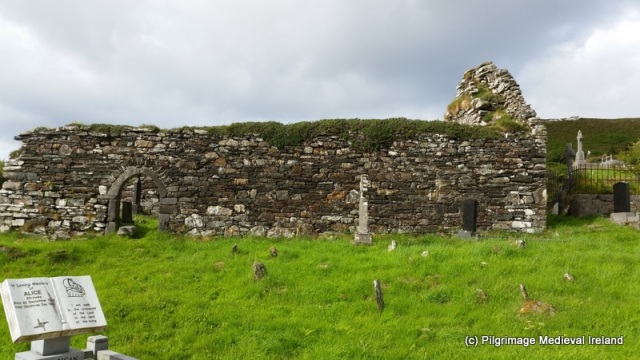Last year I was delighted to write a guest blog post about of the pilgrim site of Kilgeever in Co Mayo. This post was a guest blog for the very informative heritage blog The Standing Stone.ie. This is a great blog and worth checking out as it has lots of varied and interesting content. At the moment I am working on some research concerning this area of Mayo and as the site is fresh in my mind I have decided to repost my guest post.
Pilgrimage at Kilgeever Co Mayo. Originally posted on the Standing Stone Blog
Kilgeever/Cill Ghaobhair is located in the most scenic of setting on the slopes of Kinknock around 3km outside of Louisburg in Co Mayo. The site is part of the Clew Bay Archaeological Trail.

View of the medieval church at Kilgeever from the small laneway that leads to the site.
Local folklore holds that St Patrick came to Kilgeever having completed his fast of forty days and nights on the summit of Croagh Patrick. It is said that Patrick decided to build a church here and that he later sent St Iomhair one of his disciples completed the task. Some traditions would suggest that “Kilgeever” is the anglicised version of “Cill Iomhair” or the church of Iomhair. The Ordnance Survey Letters of 1838 translates the name as St. Geever’s Church. Curiously neither variants of the saint’s name are found in Ó’Riain’s Dictionary of Irish Saints.
Alternatively the name may derive from Cill gaobhar, ‘the near Church’ (Corlett 2001, 130) or as the Schools’ Manuscripts Essays for Louisburg(1937/38) state
Kilgeever- according to the interpretation of most people means “the windy church”.

View of Kilgeever Church and graveyard.
Almost nothing is known about the history of the site but it appears to have functioned as a parish church in the late medieval period. Today the site consists of the ruins of a multi-period medieval church surrounded by a historic graveyard, a holy well and penitential stations. At least three early medieval cross slabs are associated with the site suggesting some sort of early medieval activity. If there was an early medieval monastic settlement here as the name ‘abbey’ would imply no physical remains survive above ground.
Traditionally pilgrims visited here on the 15th of July the Feast of the Apostles and on Sundays. The Ordnance Survey Letters of 1838 refer to a pattern formerly held on the 15th of July. There was also a tradition of visiting the site on the last Sunday of July. For some pilgrims it is a key component of their pilgrimage to Croagh Patrick and having completed their pilgrimage on the summit of Croagh Patrick they descend the mountain and end their pilgrimage at Kilgeever. The ITA Files 1944 also makes reference to pilgrims visiting here from the 15th of August to the 8th of September with the annual pilgrimage day being the 15th of August.

Holy well at Kilgeever
The main focus of devotion at Kilgeever is a small holy well located in the northwest corner of the historic graveyard that surrounds the medieval church.
The Ordnance Survey Letters of 1838 state
It is a good spring and much frequented by pilgrims especially for Sundays and on the 15th of July when a pattern is held, now at Louis Borough but which was formally held at the this well.
The traditional pilgrim stations begin at this holy well, located just inside the entrance to the historic graveyard. The well is known locally as “Tobar Rí an Dhomhnaigh” or “Our Lord’s Well of the Sabbath” and the 1st ed. (1839) Ordnance Survey Map record the name of the well as Toberreendoney (Anglicisation of the former).
The Pilgrim Rounds
The pilgrimage begins with the pilgrim walking clockwise around the well forming his/her intentions. The pilgrim then kneels at the well and recites 7 Our Fathers (Paters) & 7 Hail Mary’s (Aves) and the Creed.

Holy well Kilgeever
The pilgrim stands and circles the well 7 times while reciting 7 Our Fathers, 7 Hail Marys and the Creed. Once the perambulation is completed, the pilgrim kneels again at the well and recites 7 Our Fathers, 7 Hail Marys and the Creed. It was not uncommon for pilgrims to pick up 7 stones from the well as an aid to counting the rounds dropping one stone as each circuit of the well was completed. The use of stones to count prayers is a common practice at Irish many Irish pilgrim sites especially those with complex prayer rituals.
The pilgrim then walks to the three flagstones located to the south of the well where he/she recites 5 Our Fathers, 5 Hail Marys and the creed while kneeling.
The pilgrim then proceeds to a small rock outcrop known as St Patrick’s rock where he/she kneels and rites 3 Our Fathers, 3 Hail Marys and the Creed. This stone is reputed to bear the tracks of St Patrick’s Knees (ITA Files). In modern times some pilgrims have inscribed crosses on this rocks and others around where the stations are performed.

St Patrick’s Rock
The pilgrim then walks to and enters the medieval church at the centre of the graveyard.

Kilgeever church is a multi-period church with a fifteenth doorway.
Within the interior of the church the pilgrim kneels and again recites 7 Our Fathers, 7 Hail Marys and the creed and pray for the souls of the dead. In the 1940s it was common for pilgrims to leaving the church following along the west wall (ITA Files).

Pilgrim cross carved by modern pilgrims on 19th century graveslab within Kilgeever Church.
Some pilgrims continue a modern practice of scratching a cross into a late 19th century graveslab belonging to the Mac Evilly family. When I visited the site in 2014, a number of tiny stones were left on the edge of the slab. Other accounts suggest that in the mid-twentieth century pilgrims were in the habit of leaving votive offering in the aumbry within the church. This tradition was not noticed on my visit but a number of religious objects were left at the well.

Some votive offerings left at the Kilgeever Holy Well
Having left the church the pilgrim walks back to the well via a stream that runs the length of the western side of the graveyard. If the pilgrim’s stations are being performed on behalf of a living person the pilgrim is to walk in the waters of the stream to the well. If the pilgrimage is being performed for the dead, the pilgrim walks along the edge of the stream.

Stream running along the western side of the site.
The pilgrimage is completed when the pilgrim circles the well a further 3 times prayer in honour of the Blessed Trinity. Before leaving the Holy Well pilgrims are invited to pray for Henry Murphy of Castlebar who had the cross erected over the well (as indicated by an inscription on the cross).
A photo dating to the 1890s and part to the Wynne Collection at Mayo County Library shows pilgrims kneeling in prayer at the holy well in bare feet. This photo confirms what was a common practice at the time for people to complete such pilgrimages barefoot and even today at a small number of pilgrim sites pilgrims continue this practice. The photo also shows that the well has changed little over the years with the exception of the addition of the cross which now surmounts it.

Early Medieval Cross Slab with an outline Greek cross found at Kilgeever. This is one of three cross slabs from the site.
Kilgeever is one of the most peaceful and tranquil places to visit and it is just one of many interesting sites around Clew Bay area.

View of the east gable of Kilgeever church.
References
Corlett, C. 2001. Antiquities of west Mayo: The Archaeology of the Baronies of Burrishoole and Murrish. Bray: Wordwell.
Higgins & Gibbons 1993: J.G. Higgins & Michael Gibbons. ‘Early Christian monuments at Kilgeever, Co Mayo’. Cathair na Mart, 13, 32–44.
Irish Tourist Association Files for Mayo 1944.
The Schools Collection, Louisburgh (roll number 5128/9), Volume 0137, Page 005, 006, 026, 027 (http://www.duchas.ie/en/cbes/4428011/4368055)
http://www.louisburgh-killeenheritage.org/page_id__85.aspx
http://www.logainm.ie/en/37369
http://www.thestandingstone.ie
Such a peaceful place. Lovely piece.
Reblogged this on Historical Tours Ireland.
[…] completes the traditional stations, but many of the pilgrims gofurther down the mountain to visit Kilgeever well, but this is not regardedas part of the […]